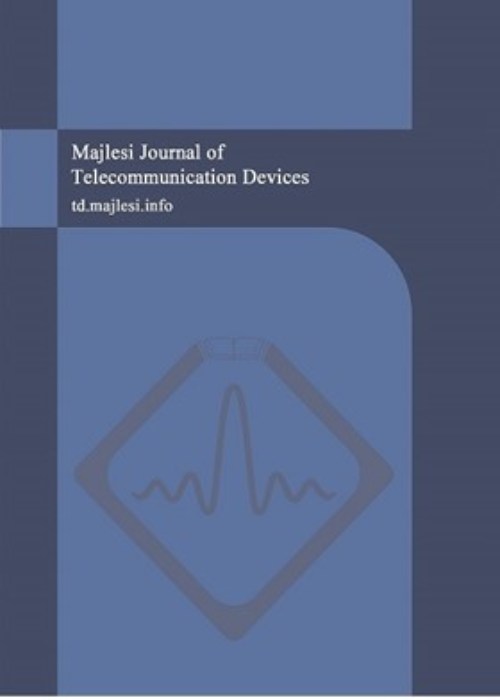فهرست مطالب
Majlesi Journal of Telecommunication Devices
Volume:3 Issue: 2, Jun 2014
- تاریخ انتشار: 1393/05/11
- تعداد عناوین: 7
-
Pages 49-54This article aims to investigate synchronization of UWB signals between transmitter and receiver in communication networks. In Ultra wideband technology, synchronization consists of two sections. In the former section coarse synchronization has been accomplished which leads to fine one at the end. In first section of coarse synchronization, maximum detection was utilized. In order to improve the performance of the synchronization algorithm and decreasing the complexity of calculation, in second section of coarse synchronization search back algorithm was presented. Synchronizations were performed in MATLAB and the results were the indication of a decrease in calculation and improvement in synchronization performance. To evaluate the performance of synchronization algorithms MAE, RMSE were utilized as two criteria and the results obtained explains the fact that RMSE criterion in search back algorithm has better performance for lower SNR.
-
Pages 55-59Fiber Ring Lasers employed for generation of the multi-wavelength laser with so narrow bandwidth. In this research, the setup of multi-wavelength fiber ring laser source is demonstrated as well as eight figure cavity that by using a piece of Polarization Maintaining Fiber (PMF) in Sagnac filter achieved four stable and constant amplitude wavelengths with same spacing at room temperature. Also, we observed more than 250 narrow line width modes by using the 23 km length of Single Mode Fiber (SMF-28) at C and L communication windows which the stability of modes because of increasing the length was more less in compare to PMF Sagnac.
-
Pages 61-64During mission all of the telecommunication and electronic components in satellites expose to ionizing radiation. This factor can cause damage to the structure and function of the satellite. This paper examines the different structures that make radiation shielding satellites in GEO orbit. In this work, the amount of ionizing radiation is calculated using the MCNPX code. The simulation results indicate the importance of each factor in designing shielding.
-
Pages 65-70The design of MMICs is essentially the same as that for most microwave components: one or more signals must be coupled onto the chip efficiently, then functions are performed on the signals, after which they are then coupled out of the chip and back into the system. the efficient coupling of signal power requires that the impedance of the signal source match that of the chip. In fact, to pass the signal efficiently through the whole chip, the impedances of the transmission lines, the active devices, and the system it sits in must all be matched. MMIC design is founded on impedance matching and control across the frequency range of interest. Gain and Noise Figure of a typical transistor is decreased and increased in terms of frequency increase, respectively.
-
Pages 71-75An ultra-low-voltage ultra-low-power operational transconductance amplifier (OTA) is presented in this paper. The proposed topology based on a bulk driven input differential pair. Two separate capacitors have been used for compensation of the opamp where one of them is used in a signal path and another one in a non-signal path. The circuit is designed in the 0.18µm CMOS technology. The simulation results show that the amplifier has a 84.1dB open-loop DC gain and a unity gain-bandwidth of 81 KHz while operating at 0.5V supply voltage. The total power consumption is as low as 900nW which makes it suitable for low-power bio-medical applications.
-
Pages 77-80This article presents an avalanche photodiode with quantum dot layers in its active region which operates at 10µm. Performance of this structure is based on intersubband impact ionization phenomenon in quantum dots. It requires lower energy threshold for the onset of avalanche phenomenon, hence it can work in lower operating voltages than bulks. In this paper, by presenting a theoretical approach for intersubband transition rate and electron-electron interaction the photo-generated current was modeled and consequently the responsivity can be calculated. Results show that peak responsivity at a voltage of 14V is obtained about 1.9 A/W. Also the dark current is modeled and calculated at different temperatures and applied voltages.
-
Pages 81-87This article introduces the reader to the performance limitations of micro electro mechanical gap-tuning capacitors fabricated in the commercially PolyMUMPs (Polysilicon Multi-user MEMS Process) foundry. And the advantages of the CMOS technology to fabrication of MEMS tunable capacitors are discussed. Also to increase the both of tuning range and quality factor, a three-plate MEMS tunable capacitor with two movable plates is designed and simulated. The simulation of the capacitor was done using the EM3DS software which is demonstrated wide tuning range (300 percent), that is 6 times higher than tuning range of the conventional parallel plate capacitor. The proposed capacitor are designed by using the ALCU metal layers of TSMC 0.18 μm CMOS technology that have caused decreasing the series resistance and increasing the quality factor to 300 in 1 GHZ.


